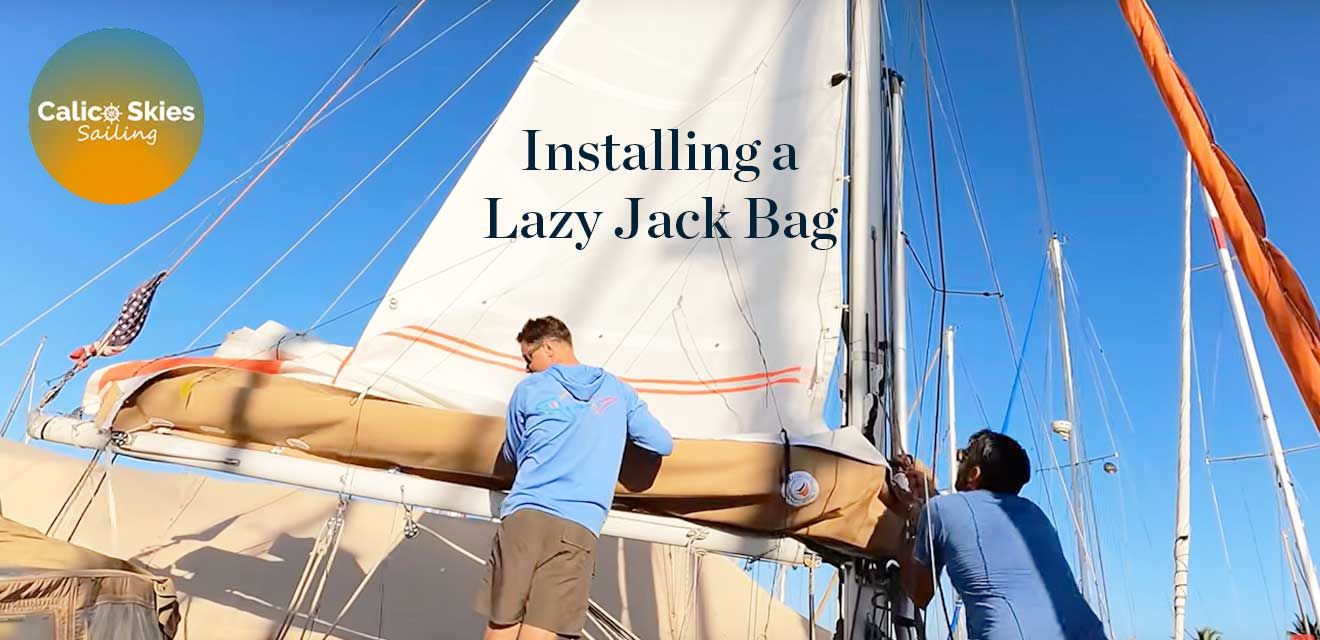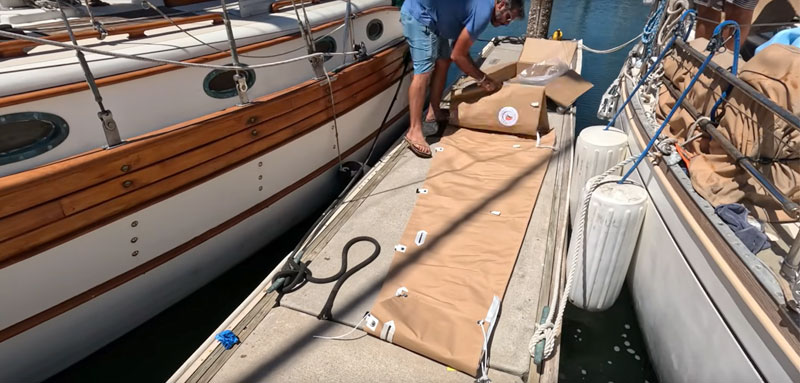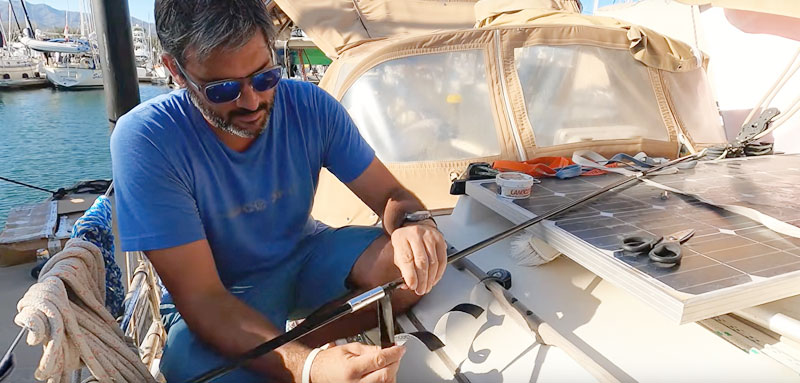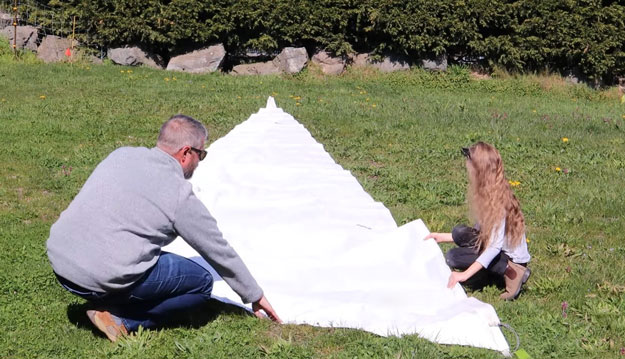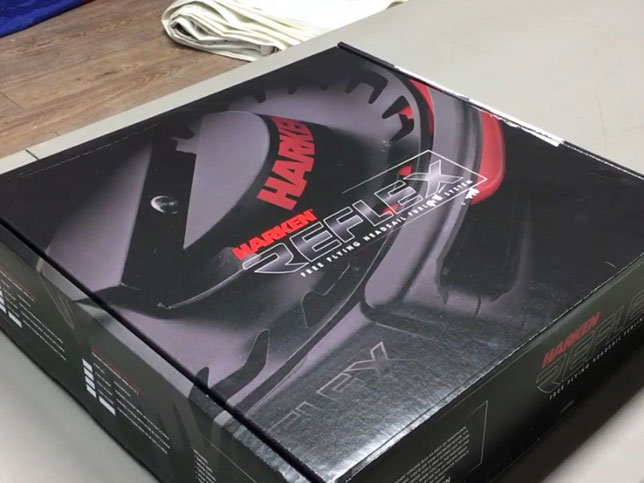Sailing enthusiasts Grace and Bill, from the Calico Skies YouTube channel, recently shared a video installing their new Precision Sails Lazy Jack Bag, also known as a stack pack. In the video they show all of the steps they took during the installation, what a stack pack is and how it works, as well as installing lazy jack lines for the first time. In this post, we will be diving into more detail with some of this information, as well as providing you with a step-by-step guide on the installation of your own lazy jack bag.
Read along or watch the full video below.
What is a Lazy Jack Bag?
Also known as a stack pack, a lazy jack bag is a way to store and protect the mainsail from UV and tough weather conditions when not in use. These bags differ from a traditional sail cover in that the bag is integrated into your boom, commonly with boom track slide cars. Whereas a traditional sail cover must be removed and reinstalled every time you want to go sailing, a stack pack is always installed and covers the mainsail when not in use with a zipper.
Before We Begin
We recommend having at least one other person to help you with the install, but more the merrier. Start by pulling everything out of the box, laying it out and making sure you have all of the necessary tools and hardware for the installation. This will also help you visualize and create a plan on how the stack pack will be installed! We also recommend tidying the deck of your sailboat and taking note of any sharp objects that could potentially rip your lazy jack bag or worse, your sail during the install.
Installing a Lazy Jack Bag
If you are like Calico Skies, you will need to begin by removing your traditional sail cover. We also recommend hoisting your mainsail so that you don’t have to work with it flaked around the boom. Now it’s time to begin the installation of your new lazy jack bag!
- If your boom has a slide track, begin by attaching each of the slide cars connected to the stack pack along your boom, underneath the foot of your mainsail. This is how the base of your lazy jack bag will be connected to your boom.
- Once all of the slide cars are attached to the boom, slide your lazy jack bag along the boom into roughly the desired location. Keep in mind, all of the Precision Sails lazy jack bags are custom designed for your mainsail with minimal slack on either end. As Calico Skies mentioned, the stack pack may appear to be too small at a first glance!
- Next, we need to install the lazy jack lines.
Installing Lazy Jack Lines
Lazy jack lines are an integral component of your stack pack. Not only do they provide support in holding up the sides of your stack pack, but the lines also act as a guide when flaking your sail.
Depending on if you previously had a stack pack or not will determine the difficulty of this installation. Similar to Calico Skies, if this is your first lazy jack bag, you will need to complete an extra couple of steps in the install. We will be walking through all of the steps today.
- Just like Grace and Bill did, we recommend using less expensive temporary lines (like paracord) in order to mock up your lazy jack system for the first time. You may need to make adjustments to the system to get it in the right orientation and with the correct tension. These lines can be replaced later with stronger, more durable line.
- Start by selecting the locations you will install your blocks up your mast on the spreaders. While planning, make sure to account for enough space for the mainsail to shift while under sail so that it does not chafe aggressively.
- Next, make sure you have all the hardware and tools you need.
- It’s time to go up the mast to mount your new blocks on the spreaders. Place the blocks in your planned positions and check the spacing. Some contact between the sail and lines is normal with lazy jack systems. Don’t forget, the secondary purpose of the lazy jack system is to help flake the sail when dropping, too much room can cause the mainsail to flake incorrectly.
Off-Season Tip: If you have your mast down for repairs or the off-season, it can be a convenient time to install your blocks without having to climb your mast. Learn how to do this here.
Installing Battens in the Stack Pack
Now that your lazy jack lines are mocked up and attached to the stack pack, it’s time to install the two battens. These battens are used with your lazy jack bag to provide additional support and rigidity, allowing the bag to keep its shape while under sail and easier flaking of the mainsail without getting caught on loose sections of the stack pack.
We use multi-piece battens so that they are easier to ship with less chance of breaking. Simply attach the battens together and use the provided tape (electrical tape works as well) to wrap around the batten at each of the joints. This will create a smoother transition at the joints, allow the batten to glide through the batten pocket in your stack pack without getting snagged or causing any ripping.
Time for Testing
With everything mocked up, it’s time to try flaking your mainsail into the lazy jack bag! We recommend fully flaking the sail and closing the bag in order to lock in its final position.
After you have tested your new lazy jack bag, you can swap the temporary lines you used for higher quality, stronger lines for a more permanent attachment!
Watch Calico Skies Install Their Lazy Jack Bag
Grace and Bill’s journey began several years ago when they made the bold decision to leave their conventional lives behind and embrace the boundless beauty of the ocean. Their experiences, challenges, and breathtaking moments have captivated sailing enthusiasts worldwide through their Calico Skies YouTube channel. They inspire sailors of all levels to embark on their own adventures, and they emphasize the importance of investing in quality sails and ensuring all sailing equipment is in top-notch condition for long voyages across oceans.
Ready To Get Started?
Click the button below to set a time for us to finalize your Lazy Jack Bag order, or give us a call at 1-888-958-5638.
Review and Order